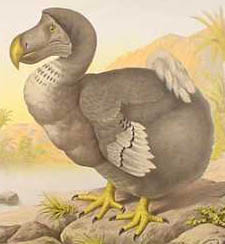The Dodo Bird: Environmental History Lessons
14 January 2014 - 6:44pm

It is hard not to smile when encountering images of dodo birds. From their large hooked beaks to their short legs and round forms, they have a cartoonish appearance that captures the imagination. Although they went extinct around 1681, they remain an easily recognizable bird, and representations of dodos can be found in books, movies, advertisements and collectibles. Well-known literary examples include Dodo in Alice in Wonderland, and the delightful pet dodos that populate Jasper Fforde's Thursday Next book series with their cheerful “plock plock” noises. The iconic image of the dodo bird, however, is likely inaccurate. A relative of the pigeon, the bird was not quite as plump as some drawings might portray, but its inability to fly made it a vulnerable target when people, and their cats, dogs and rats, landed on the Island of Mauritius and discovered it in 1598.
It can be difficult to understand the impact we have on the environment around us. The world seems so big, and an individual person so small, and understanding how we fit into complex ecosystems can be challenging. One way for students to start to think about human impact and environmental history is by looking at what happens in isolated environments, such as islands. These are places where animals have evolved separately from the invasive species that enter their worlds at later times, causing them trouble.
The dodo bird was completely unprepared for the Dutch sailors and their ships. Although sailors did not seem fond of the taste of the bird, which was described as tough and bland, they did hunt them and the animals from their ships and found them to be easy prey. It did not take long for the dodo bird to be completely wiped out, unintentionally or not.
Some dodos were removed from the island and taken back to Europe, and there are museums around the world that have parts of dodos today. Most specimens have not survived to today, or are now incomplete due to pests or disasters. The most complete parts of a dodo, a mummified head and foot, can be found at the Oxford Museum of Natural History in England.
The dodo is a sad reminder of how easily humans can irreversibly damage an ecosystem or cause extinctions. The story of the dodo bird can provide students with an accessible lesson in environmental history and evolution in isolation.
A few examples of museum dodo collections and additional dodo information provided by museums:
Oxford Museum of Natural History Oxford, England: http://www.oum.ox.ac.uk/learning/htmls/dodo.htm
Additional Information: http://www.oum.ox.ac.uk/learning/pdfs/dodo.pdf
Natural History Museum, London, England: http://www.nhm.ac.uk/nature-online/collections-at-the-museum/museum-treasures/dodo-skeleton/index.html
Dodo Bones, Grant Museum of Zoology, London, England: http://www.ucl.ac.uk/museums/zoology/about/collections/objects/dodo-bones
American Museum of Natural History: http://www.amnh.org/exhibitions/permanent-exhibitions/biodiversity-and-environmental-halls/hall-of-biodiversity/dodo
The Canadian Museum of Nature:
http://www.nature.ca/notebooks/english/dodo.htm
How do you deal with extinction in your classroom/museum?
Photo: Dodo, Raphus cucullatus (anonymous artwork c. 1880; facsimile of 1626 painting by Roelant Savery), from Wikipedia Commons.

